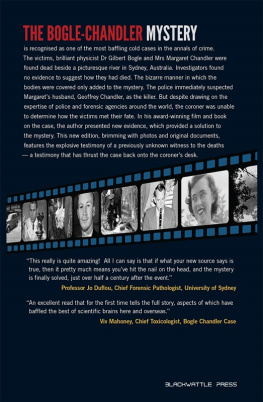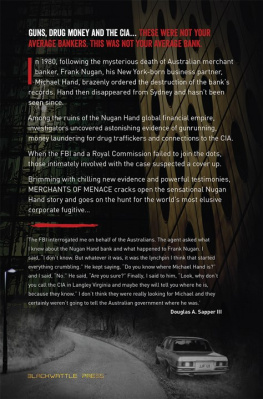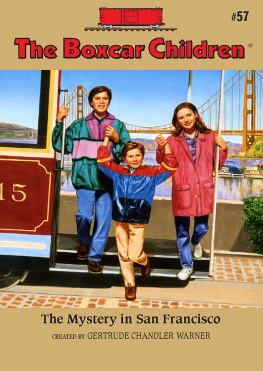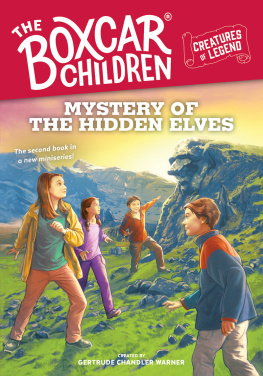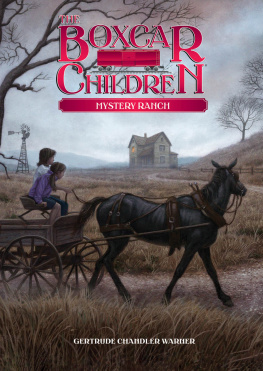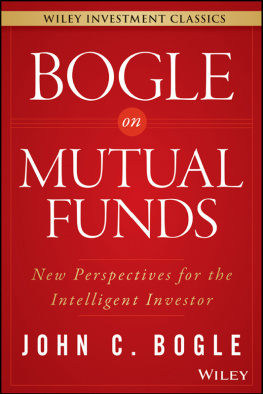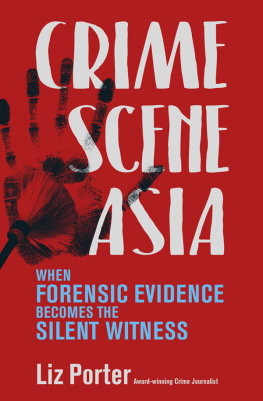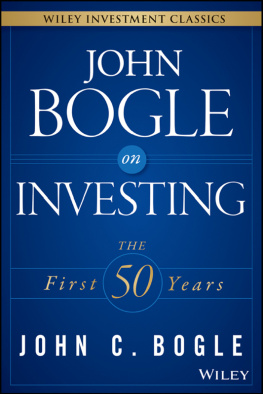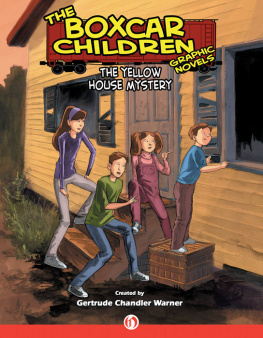Blackwattle Press
Sydney, Australia
Copyright Peter Butt 2016
First published as Who Killed Dr Bogle & Mrs Chandler? by New Holland Publishers
This revised edition, Dr Bogle & Mrs Chandler The Confession, published by Blackwattle Press 2016
Copyright 2016 in photographs: Peter Butt and individual copyright holders
Copyright 2016 Blackwattle Press
All rights reserved. No part of this publication may be reproduced, stored in a retrieval system or transmitted, in any form or by any means, electronic, mechanical, photocopying, recording or otherwise, without the prior written permission of the publishers and copyright holders.
A catalogue record of this book is available at the National Library of Australia
ISBN: 978-0-9923252-1-3 (pbk)
ISBN: 978-0-9923252-3-7 (eBook)
1. Dr Gilbert Bogle. 2. Mrs Margaret Chandler. 3. Bogle-Chandler police investigation New South Wales Sydney. 4. Lane Cove River New South Wales Sydney.
5. Pollution. I. Title. II. Butt, Peter.
Publisher: Peter Butt
Associate Publisher: Sarah Staveley
Design: Working Type
This project has been kindly assisted by the National Film & Sound Archive.
Website: www.blackwattlepress.com.au
Facebook: www.facebook.com/BlackwattlePress
ABOUT THE AUTHOR
P eter Butt is an Australian investigative filmmaker. Over the last three decades he has produced and directed major history series and dozens of documentary specials for local and international broadcasters. His multi-award winning docudrama Who Killed Dr Bogle & Mrs Chandler? for the ABC remains the highest-rating commissioned documentary in the broadcasters history.
In September 2012 Peter published a book on the Bogle-Chandler case, which went into far greater detail than the film and confirmed the identity of the person who covered the bodies. The book was shortlisted for the 2014 NSW Premiers Literary AwardsDouglas Stewart Prize for Non Fiction.
This new edition features a major development in the casea confession by a person who witnessed the deaths of Dr Bogle and Mrs Chandler.
Peter Butt is also the author of Merchants of Menace, a reinvestigation of the notorious Nugan Hand bank.
DOUGLAS STEWART PRIZE JUDGES COMMENTS
T he Bogle and Chandler case was one of the most famous unsolved mysteries in Australia, involving an eminent scientist and the wife of one of his colleagues found dead and nearly naked on the banks of the Lane Cove River in Sydney. Peter Butt has taken up the challenge of solving the mystery in this true crime narrative, as he uncovers the original investigation, interviews all the participants and comes up with an unexpectedand convincingnew theory. Its a theory that moves the book from whodunnit into environmental thriller without ever losing its command of the evidence or narrative style.
Peter Butt has marshalled a vast array of information and interviewed dozens of people, pulling together an involving, fast-paced story with the significant contemporary themes of gender and the environment. The writing is clear and engaging, even when he presents detailed scientific material; the characterisations are compelling, the culture of the period is well observed and the exploration of how the Bogle and Chandler deaths happened is fascinating. The opening out of the story into a social and environmental context makes this a valuable contribution to both true crime and environmental literature.
CONTENTS
FOREWORD
W ould the deaths of Dr Bogle and Mrs Chandler have been solved if todays forensic science techniques had been available in the early 1960s? You would hope the answer is in the affirmative, but in reality Im not too sure. Contemporary forensic science includes a vast array of applied technology and scientific endeavour, including the areas of molecular biology, advanced toxicological techniques, immuno-assays, robotic systems, and computerised imaging to name a few. In some ways, television shows such as CSI and NCIS are the greatest prime-time ads for forensic science. Complex plots, photogenic and witty characters, high tech equipment and outstanding detective work combine to get their man.
In fact, real life forensic science is more often reflected in the genre typified by the X-Files, complete with conspiracy theory, uncertainty, doubt and multiple theories, many of which are simply outrageous. Technology invariably plays a support role to the investigative skills of numerous groups of people, and complex cases can take months, if not years, of hard work to solve. If lucky, the case is taken to court, either the Coroners Court or the various criminal courts, where the case is lost or won. To the jury member, the expert in the witness box must be a strange creature, and definitely very different to the heroic television forensic scientist. The alleged expert invariably does not express certainty, but rather presents evidence peppered with I dont know, I cant tell, Im not sure, maybe and possibly. Surely the scientist is incompetent and evasive? In fact, the chances are nowhat the scientist is trying to explain is the uncertainty that pervades all aspects of forensic science, and it is invariably the confident and definite forensic scientist who has a poor appreciation of the limitations of their work. So is this any different to the 1960s? Probably yes, but above all else, forensic scientists have become more cognisant of the fallibility and uncertainty inherent in their techniques, and they express their doubt more clearly.
The investigation of death scenes has progressed by leaps and bounds. What was often a haphazard and quick look-over by a police scientific officer now can involve multiple experts attending in sequential fashion, each adding their expertise to the investigation. Simple suspicious death scenes commonly take 12 hours or longer to process, and some can take whole teams of investigators many days at the location alone. The autopsy, similarly, can easily take an entire day to perform the basic investigations, followed by months of additional investigations including toxicology, molecular biology (or DNA) and other esoteric investigations. But the process has remained roughly the same over the last half centuryforensic scientists investigating a death, using relatively limited technological assistance. In most suspicious deaths, the cause of death is obvious, be it a shooting, stabbing, poisoning or strangulation. Possibly with the exception of DNA testing, if the investigator has to rely on esoteric science for an answer, the chances are that answer will not be found.
But what about the deaths of Bogle and Chandler specifically? The scene appeared straightforward: two dead lovers at the side of a river. There was minimal physical evidence to retrieve, and documentation was easy. There were only minor injuries to both persons, and these were consistent with crawling on the undergrowth. Therefore, the method whereby they died must surely have been poisoning. It would be hard to realistically consider any other method, but it always pays to keep an open mind. The autopsies were essentially negativecharacteristic of a poisoning death. Relevant specimens were sent to the analyst for detection of drugs and poisons, but this, of course, is where the whole investigation collapsed. There were simply no drugs, no poisons. For that matter, there were also no communist death rays, lasers, crocodile bile, or the myriad other bizarre and pure fantastical theories. The causes of death of both Dr Bogle and Mrs Chandler, no matter how hard investigators tried, stubbornly remained Undetermined. This is not how it is meant to happen in

